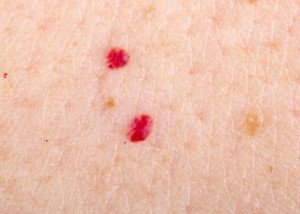
There are numerous causes of red spots on the tongue, and unfortunately, cancer is one of them.
However, this isn’t the most likely cause of what you might perceive to be red “spots” on your tongue. Let’s first look at non-malignant causes.
“Vitamin B12 deficiency can cause red spots on the tongue,” says Richard Bezozo, MD, President of MoleSafe, the world’s most advanced melanoma screening program.
He says that scarlet fever and strep infection can also cause red spots on the tongue.
“Thrush, a yeast infection of the mucus membrane lining the mouth and tongue, can also cause red spots,” says Dr. Bezozo.
“Common causes of yeast infection oral candidiasis include antibiotic use, HIV infection or other immunodeficiency conditions.”
Tongue Cancer Appearance
Tongue cancer often presents with distinct changes in the appearance of this muscle.
One of the first signs of this condition is the development of a red or white patch on the tongue.
While this discolored area might initially appear as a small spot, it is more commonly observed as a larger patch or splotch that can appear anywhere on the tongue’s surface.
As the cancerous lesion progresses, it typically exhibits raised edges and becomes increasingly firm to the touch.
The texture of the lesion may become harder over time, making it more noticeable.
In advanced stages, the center of the lesion often becomes ulcerated and prone to bleeding.
This bleeding can occur easily with applied pressure, such as during activities like chewing or swallowing.
The lesion may break open more readily under such conditions, leading to discomfort and additional bleeding.
These symptoms are significant and warrant prompt medical attention.
Other Symptoms of Tongue Cancer
• Pain when swallowing or without
• The tongue is stiff.
• Feeling that something is stuck in the throat.
• Problems chewing or a stiff-feeling jaw
• Tasting blood (from bleeding in the mouth)
• Numbness involving the mouth
Risk Factors
• Any kind of tobacco use — smoking, chewing; cigarettes, cigars, pipes
• Heavy drinking (combination of smoking and heavy drinking significantly boosts risk)
• Standard American diet: lots of processed foods such as luncheon meats, microwavable dinners and side dishes, fast foods, bakery, and few fruits and vegetables
• History of an HPV infection
• Family history of oral cancer
• Male, over age 50, but don’t let this make you think that women are immune.
• Chronic acid reflux (GERD)
• Exposure to asbestos or formaldehyde
• Poor oral hygiene
• Bad fitting dentures
Malignant lesions may be tender. And this can’t be said too much: Beware of red spots on the tongue that bleed; this is a strong indication of cancer.
 Lorra Garrick has been covering medical, fitness and cybersecurity topics for many years, having written thousands of articles for print magazines and websites, including as a ghostwriter. She’s also a former ACE-certified personal trainer.
Lorra Garrick has been covering medical, fitness and cybersecurity topics for many years, having written thousands of articles for print magazines and websites, including as a ghostwriter. She’s also a former ACE-certified personal trainer.

Richard Bezozo, MD
There are more new cases yearly of skin cancer than breast, prostate, lung and colon cancers combined. The MoleSafe system produces high-resolution diagnostic images and creates a profile for your skin that’s monitored for any changes in moles.
.









































